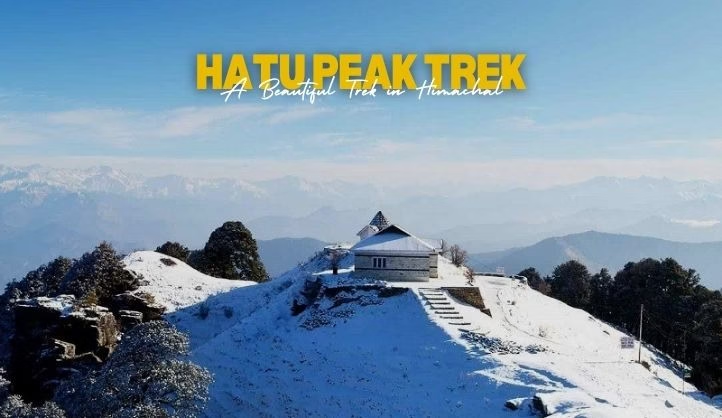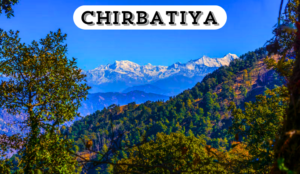Hatu Peak, located in the Shimla district of Himachal Pradesh, is a popular trekking destination that offers a stunning blend of natural beauty and adventure. Rising to an altitude of about 3,400 meters (11,152 feet) above sea level, it is the highest peak in the region and provides mesmerizing views of the surrounding Himalayan ranges. The trek to Hatu Peak is relatively easy and is ideal for beginners and experienced trekkers alike. Apart from its breathtaking vistas, the peak is famous for its religious significance and lush green surroundings.
How to Reach Hatu Peak
By Air
The nearest airport to Hatu Peak is Jubbarhatti Airport in Shimla, about 80 km away. From the airport, one can hire a taxi or take a bus to Narkanda, which serves as the base for the trek. Alternatively, travelers can fly to Chandigarh Airport (around 190 km away), which offers better connectivity, and then proceed to Narkanda via road.
By Train
The closest railway station is in Kalka, around 125 km from Narkanda. From Kalka, one can either take a taxi or enjoy the scenic ride on the Kalka-Shimla toy train, which is a UNESCO heritage railway. The train ride offers a picturesque journey through tunnels, bridges, and pine-covered hills, followed by a road journey from Shimla to Narkanda.
By Road
Narkanda is well-connected by road from major cities like Shimla (60 km), Chandigarh (180 km), and Delhi (400 km). Regular buses and taxis operate between Shimla and Narkanda. The road journey is a thrilling experience with winding mountain roads and mesmerizing valley views.
Trekking Route to Hatu Peak
The trek to Hatu Peak starts from Narkanda, a quaint town known for its apple orchards and serene landscapes. The trek is a 7-km-long trail that takes 3 to 4 hours to reach the summit, depending on the trekker’s pace.
Trail Highlights
- Dense Forests: The trek passes through thick forests of deodar, oak, fir, and rhododendron trees, creating a refreshing and serene environment. The cool shade of these trees makes the trek comfortable even during sunny days.
- Wildlife Sightings: Trekkers may come across Himalayan Monals (the state bird of Himachal Pradesh), langurs, barking deer, and various species of butterflies.
- Panoramic Views: As you ascend, breathtaking views of snow-capped Himalayan peaks, including the Shrikhand Mahadev, Kinnaur Kailash, and Swargarohini ranges, become visible.
- Hatu Mata Temple: At the summit, there is the famous Hatu Mata Temple, dedicated to Goddess Kali. The temple is a wooden structure with intricate carvings, showcasing the traditional Himachali architectural style.
- Steep Ascents and Rocky Terrain: While most of the trail is gradual, the final stretch towards the summit has steep inclines and rocky paths, making it slightly challenging but rewarding.
Best Time to Visit
The best time to embark on the Hatu Peak trek is from April to June and September to November. These months offer clear skies, pleasant weather, and lush green landscapes.
- Spring and Summer (April-June): Ideal for trekking as the weather is mild, and the forests are in full bloom with vibrant flowers.
- Autumn (September-November): Provides stunning views of the golden-hued forests, crisp mountain air, and clear visibility.
- Winter (December-March): The trek is covered in snow, making it more challenging but rewarding for experienced trekkers. Snow trekking enthusiasts visit during this time for an adventurous experience.
Things to Carry for the Trek
- Trekking Shoes: Comfortable, waterproof shoes with good grip are essential.
- Warm Clothing: Even during summer, temperatures at the peak can be chilly. Carry a fleece jacket, thermal wear, and a windproof jacket.
- Water Bottles: Stay hydrated during the trek.
- Energy Snacks: Carry dry fruits, protein bars, and chocolates for instant energy.
- Sunglasses and Sunscreen: The sun at high altitudes can be harsh.
- First Aid Kit: Carry basic medicines, band-aids, and antiseptics.
- Trekking Pole: Helps maintain balance, especially in steep areas.
- Raincoat/Poncho: Sudden weather changes are common in the mountains.
- Camera: To capture the breathtaking views of the Himalayas.
Accommodation and Food Options
Narkanda has several hotels, homestays, and guesthouses for trekkers to stay overnight before or after the trek. Some popular options include Hatu Valley Homestay, Tethys Ski Resort, and PWD Guest House.
At Hatu Peak, there are no accommodation facilities, so it is recommended to return to Narkanda the same day. However, some trekkers prefer to camp overnight at the peak, enjoying the sunrise and stargazing.
Food stalls in Narkanda offer delicious Himachali cuisine, including:
- Siddu: Siddu is a steamed bread stuffed with poppy seeds and nuts.
- Chana Madra: Chana Madra is a chickpea curry with yogurt-based gravy.
- Rajma Chawal: Red kidney beans served with rice.
- Local Herbal Tea: Made from Himalayan herbs, providing warmth and relaxation.
Nearby Attractions
- Tanni Jubbar Lake: A small yet picturesque lake surrounded by lush green meadows, perfect for relaxation and photography.
- Stokes Farm: Famous for its apple orchards, where visitors can buy fresh apples and apple-based products.
- Mahasu Peak: Another scenic peak near Narkanda, ideal for short hikes and breathtaking views.
- Kotgarh and Thanedar: Known for apple farming, these villages offer a peaceful getaway with traditional Himachali culture and scenic landscapes.
Tips for a Safe and Enjoyable Trek
- Start Early: Begin the trek in the morning to complete it before sunset.
- Check the Weather Forecast: Avoid trekking during heavy rainfall or snowfall.
- Stay Hydrated: Carry enough water, as there are no water sources on the trail.
- Travel in Groups: It is safer to trek with a group, especially for first-time trekkers.
- Respect Nature: Avoid littering, do not pluck flowers, and maintain cleanliness on the trail.
- Carry Cash: ATMs are limited in the region, so carry some cash for emergencies.
Conclusion
Hatu Peak trek is a perfect blend of adventure, spirituality, and natural beauty, making it a must-visit for trekking enthusiasts and nature lovers. Whether you’re looking for an easy yet scenic hike or seeking solitude in the lap of the Himalayas, this trek offers a truly rewarding experience.
FAQs About Hatu Peak Trek
1. Is the Hatu Peak trek suitable for beginners?
Yes, the trek is moderate and can be done by beginners with basic fitness levels.
2. How long does it take to complete the trek?
It takes about 3-4 hours to reach the peak from Narkanda and around 2 hours to descend.
3. Is there any permission required for the trek?
No special permission is required for trekking to Hatu Peak.
4. Can I camp at Hatu Peak?
Yes, camping is possible, but there are no facilities. Trekkers must carry their own camping gear and essentials.
5. What are the transport options available from Shimla to Narkanda?
Regular buses and taxis operate between Shimla and Narkanda.





